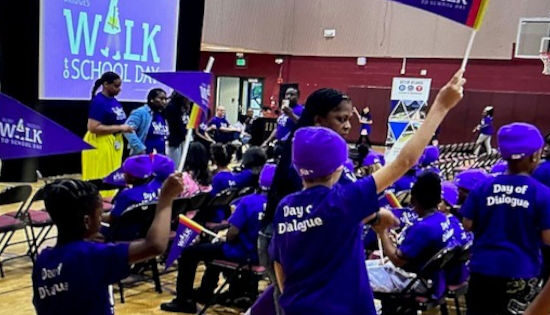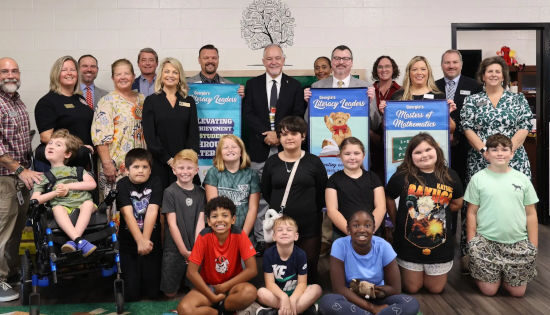ATLANTA – The Georgia Department of Education announces that the 2025 CCRPI shows improvements in Content Mastery and Readiness.
Release:
NOTE ON COMPARABILITY: The Content Mastery, Progress, Readiness, and Graduation Rate components are comparable between 2024 and 2025. The Closing Gaps component is not comparable between 2024 and 2025, as 2024 flags did not include mathematics due to the implementation of new mathematics standards and assessments in the 2023-2024 school year.
The 2025 College & Career Ready Performance Index (CCRPI) shows improvements across all grade bands in Content Mastery and Readiness, along with Graduation Rate for high schools.
The Content Mastery component includes student scores on statewide assessments in English Language Arts (ELA), mathematics, science, and social studies while the Readiness component includes the percentage of students at or above grade-level reading, student attendance, the percentage of students succeeding in “beyond the core” instruction, accelerated enrollment, pathway completion, and college and career readiness measures. Graduation Rate includes both the four- and five-year graduation rates.
“This year’s College and Career Ready Performance Index scores show strong improvements in our students’ academic achievement and their preparation for life,” State School Superintendent Richard Woods said. “They also point the way toward areas where we can continue to grow and expand opportunities in all of Georgia’s public schools. I am proud of the teachers, leaders, and families who continue to work hard each day to produce strong results for Georgia’s students – and I’m proud of the students themselves. As the school districts highlighted here make clear, these are not just numbers and data points. When we see improvement in Georgia’s public schools, that has an impact on 1.7 million children – that’s what matters most.”
More Information on 2025 CCRPI Scores
The CCRPI includes five components: Content Mastery, Progress, Closing Gaps, Readiness, and – for high schools – Graduation Rate. Descriptions of each component are included in the “About the CCRPI” section of this release.
In 2025, scores improved across grade bands in Content Mastery and Readiness, and Graduation Rate (which is only measured at the high school level) also improved. The Progress Component, which measures student growth in ELA and mathematics and English Learners’ progress toward English language proficiency, increased for the middle school grade band and showed slight decreases (less than one percentage point) for elementary and high school. The Closing Gaps component is not directly comparable from 2024 to 2025.
| Components | Elementary | Middle | High |
| Content Mastery | 68.0 (+0.2) | 65.6 (+1.6) | 69.2 (+1.0) |
| Progress | 86.1 (-0.1) | 83.1 (+0.8) | 82.2 (-0.5) |
| Closing Gaps | 75.0 (not comparable) | 86.3 (not comparable) | 71.3 (not comparable) |
| Readiness | 84.1 (+0.9) | 83.2 (+0.4) | 75.4 (+2.1) |
| Graduation Rate | N/A | N/A | 87.2 (+1.5) |
District stories show the power of relationships and relevance in student learning
Click here for the full versions of the four district spotlights below.
Baker County Schools
Baker County Schools, a small district enrolling just over 300 students in southwest Georgia, saw gains in Content Mastery across all grade bands – with an 8.8-percentage-point gain in middle school. In Baker County, teachers worked to unpack the new mathematics standards, weave in writing across the curriculum, increase student engagement, and bring the community into the classroom. Teachers focused on helping students analyze and evaluate information, write about their learning, and stay engaged through meaningful lessons and mentorship.
Ultimately, it was the relationships teachers built with their students that made the biggest difference. Students realized their teachers were serious about their learning – and cared about them as people, too. Teachers encouraged their students to engage in extracurricular activities and showed up to cheer them on when they did.
“I tell them, when you hear your name called, you know that’s Mrs. Hawkins calling your name,” math teacher Gail Hawkins said. “Win, lose, or draw, I’m here to support you.”
Click here to read the full version of this story.
Bibb County Schools
In Bibb County Schools, teachers and leaders embraced personalized learning – an approach that tailors instruction to each student’s needs and interests while helping them take ownership of their growth. The district’s high schools saw a 5.5-percentage-point gain in Content Mastery as students learned to set goals, track progress, and reflect on their learning. School leaders also focused on collaboration, building trust and clarity among teachers, and strengthening relationships with families.
Above all, they worked to keep the focus on students as individuals.
“You have to turn your numbers into names,” Howard High School Principal Michael Scott said. “We’re all looking at data points all day, but these are real human beings. In our data team meetings, we call our students by name. We know where they are, and what barriers are in the way that we need to remove to get to the next level. Our students are real human beings. They have an identity. That’s who we’re working with every day.”
Click here to read the full version of this story.
Calhoun County Schools
In Calhoun County Schools, leaders worked to strengthen supports for standards-aligned instruction and bring learning to life through hands-on activities. The district saw strong gains in Content Mastery across all grade bands – 11.8 percentage points in elementary, 7.1 points in middle, and 12.4 points in high school. Teachers focused on building student engagement, integrating hands-on learning, and preparing every student for future success through consistent, high-quality instruction.
Superintendent Pamela Quimbley, who was previously an elementary school principal and has known many of her graduates and soon-to-be graduates throughout their entire educational careers, described her desire to ensure students graduate on a pathway to success.
“Either they will become employed, they will enroll in a postsecondary institution, or they will enlist in the military,” Quimbley said. “That is the vision I have for our students – for them to become productive citizens.”
Click here to read the full version of this story.
Henry County Schools
In Henry County Schools, educators focused on student achievement and wellbeing in tandem – anchored by the goal of helping every student find a positive purpose to guide their learning. Schools tailored instruction, intentionally built time for teachers to plan high-quality lessons, and ensured every student was engaged and connected to their future goals.
These efforts led to gains in Content Mastery across grade bands, including a 4.9-percentage-point gain for the district’s elementary schools.
“I have tasked our schools, our teachers, our principals, with helping our students find a positive purpose,” Superintendent Dr. John Pace said. “What’s their positive purpose in life? If we can help them find that, the pathway to learning becomes easy. They’re able to connect.”
Click here to read the full version of this story.
About the CCRPI
Under the federal Every Student Succeeds Act (ESSA), each U.S. state is required to have a statewide accountability system that complies with federal requirements, providing information on how well schools are performing. The CCRPI meets that requirement in Georgia and satisfies requirements for school accountability in state law.
The CCRPI measures school, district, and state performance on five components:
- Content Mastery includes student scores on statewide assessments in English Language Arts, mathematics, science, and social studies.
- Progress measures how much growth students demonstrate in English Language Arts and mathematics and how well English Learners are progressing toward English language proficiency.
- Closing Gaps measures how well schools meet annual improvement targets for student groups.
- Readiness includes the percentage of students at or above grade-level reading, student attendance, the percentage of students succeeding in “beyond the core” instruction, accelerated enrollment, pathway completion, and college and career readiness measures.
- Graduation Rate includes both the 4- and 5-year graduation rates and is a high school component.
CCRPI scores are used to identify Comprehensive Support & Improvement (CSI) and Targeted Support & Improvement (TSI) schools which receive additional state support. TSI schools will be identified later this year using 2025 data. CSI schools are served for three years and will next be identified using 2026 data.
The CCRPI no longer includes an overall 0-100 score for schools, districts, or the state. Each CCRPI component still has a 0-100 score. This change was made to increase transparency and provide a more complete picture of school performance, ensuring that challenges and opportunities are not hidden behind a single score.
Legislation passed in 2024 requires the Governor’s Office of Student Achievement (GOSA) to calculate a single score for schools and districts and for GaDOE and local school districts to publish these scores online. GaDOE will publish GOSA single scores as soon as they are available.










